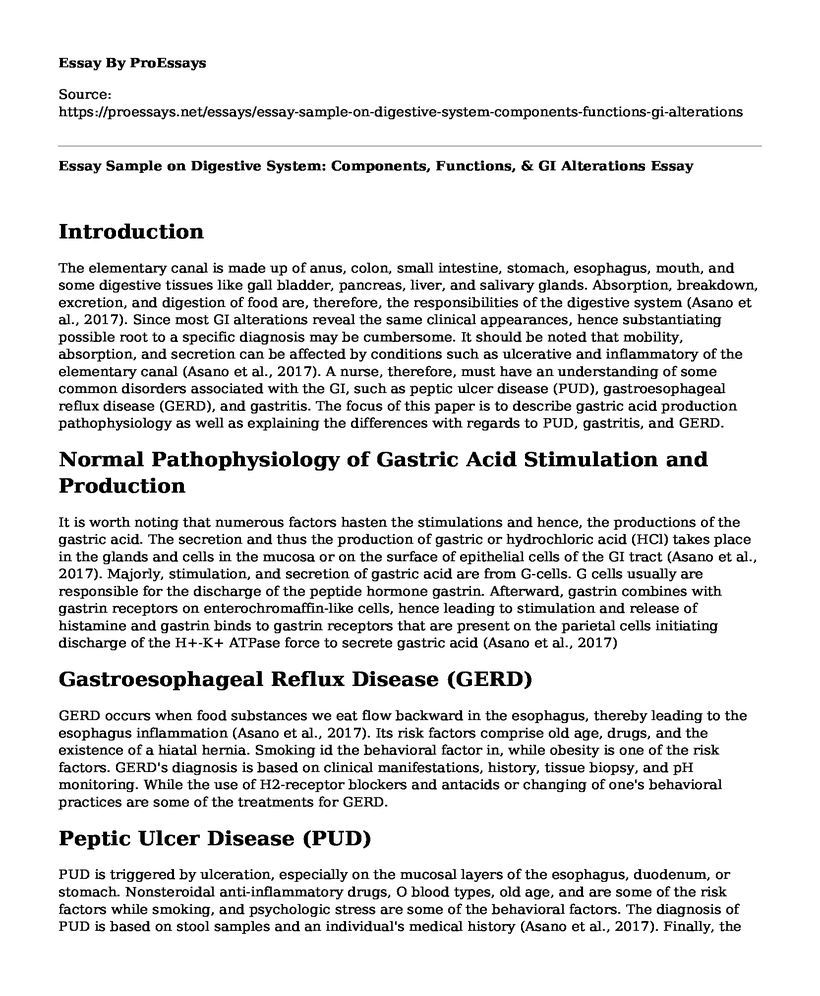Introduction
The elementary canal is made up of anus, colon, small intestine, stomach, esophagus, mouth, and some digestive tissues like gall bladder, pancreas, liver, and salivary glands. Absorption, breakdown, excretion, and digestion of food are, therefore, the responsibilities of the digestive system (Asano et al., 2017). Since most GI alterations reveal the same clinical appearances, hence substantiating possible root to a specific diagnosis may be cumbersome. It should be noted that mobility, absorption, and secretion can be affected by conditions such as ulcerative and inflammatory of the elementary canal (Asano et al., 2017). A nurse, therefore, must have an understanding of some common disorders associated with the GI, such as peptic ulcer disease (PUD), gastroesophageal reflux disease (GERD), and gastritis. The focus of this paper is to describe gastric acid production pathophysiology as well as explaining the differences with regards to PUD, gastritis, and GERD.
Normal Pathophysiology of Gastric Acid Stimulation and Production
It is worth noting that numerous factors hasten the stimulations and hence, the productions of the gastric acid. The secretion and thus the production of gastric or hydrochloric acid (HCl) takes place in the glands and cells in the mucosa or on the surface of epithelial cells of the GI tract (Asano et al., 2017). Majorly, stimulation, and secretion of gastric acid are from G-cells. G cells usually are responsible for the discharge of the peptide hormone gastrin. Afterward, gastrin combines with gastrin receptors on enterochromaffin-like cells, hence leading to stimulation and release of histamine and gastrin binds to gastrin receptors that are present on the parietal cells initiating discharge of the H+-K+ ATPase force to secrete gastric acid (Asano et al., 2017)
Gastroesophageal Reflux Disease (GERD)
GERD occurs when food substances we eat flow backward in the esophagus, thereby leading to the esophagus inflammation (Asano et al., 2017). Its risk factors comprise old age, drugs, and the existence of a hiatal hernia. Smoking id the behavioral factor in, while obesity is one of the risk factors. GERD's diagnosis is based on clinical manifestations, history, tissue biopsy, and pH monitoring. While the use of H2-receptor blockers and antacids or changing of one's behavioral practices are some of the treatments for GERD.
Peptic Ulcer Disease (PUD)
PUD is triggered by ulceration, especially on the mucosal layers of the esophagus, duodenum, or stomach. Nonsteroidal anti-inflammatory drugs, O blood types, old age, and are some of the risk factors while smoking, and psychologic stress are some of the behavioral factors. The diagnosis of PUD is based on stool samples and an individual's medical history (Asano et al., 2017). Finally, the H2 receptor blocker and antibiotics are some of the treatment of PUD.
Gastritis
It is worth noting that both GERD and PUD exhibit the existence of gastritis. The occurrence of Gastritis usually is when the stomach's mucosal layer swells due to increased gastric discharge that is triggered by trauma or drugs (Asano et al., 2017). Alcohol and smoking are some of the behavioral factors, while the sexually transmitted disease is a risk factor for gastritis. Gastritis is predominant in adults with advanced ages and is triggered by chronic inflammation and mucosal atrophy. Evaluation of and individual's medical history, and blood are some of the diagnosis requirements (Asano et al., 2017). On the other hand, a reduction in the level of antacids and stomach acidity are some of the standard treatment practices.
Conclusion
The intersection of clinical exhibitions in GERD, PUD, and gastritis can make it cumbersome to substantiate the appropriate diagnosis, especially when blood or stool tests and endoscopic evaluation are not administered. Generally, all alterations discussed can be mitigated by improving one's lifestyle, implementing changes in diets, and avoid drugs such as nicotine and alcohol. It is also worth noting that the treatments `for all the alterations are almost the same as the treatments of the underlying causes merely by the use of H2-receptor blockers and antacids.
References
Asano, H., Tomita, T., Nakamura, K., Yamasaki, T., Okugawa, T., & Kondo, T. et al. (2017). Prevalence of Gastric Motility Disorders in Patients with Functional Dyspepsia. Journal Of Neurogastroenterology And Motility, 23(3), 392-399. DOI: 10.5056/jnm16173
Cite this page
Essay Sample on Digestive System: Components, Functions, & GI Alterations. (2023, Feb 27). Retrieved from https://proessays.net/essays/essay-sample-on-digestive-system-components-functions-gi-alterations
If you are the original author of this essay and no longer wish to have it published on the ProEssays website, please click below to request its removal:
- Essay Sample on Digestive and Respiratory System
- Essay Sample on Metabolism and Urinary System
- Essay Example on Superior & Inferior Muscles of the Eye: Function & Movement
- Essay Example on Genome Editing: A Potential Cure for Sickle Cell Disease?
- Essay Sample on California's Weather: Planning Ahead for Extreme Conditions
- GMOs: Benefits and Risks in Feeding a Growing Population - Essay Sample
- Irrigation: Providing Water for Plant Growth in Arid Areas - Essay Sample







